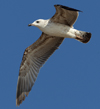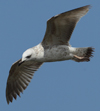2cy armenicus: February
Distribution:
Larus armenicus breeds in southern Caucasia: Armenia, Georgia (only about 50 pairs), eastern Turkey and irregularly in central Turkey. Undocumented populations in Irak and Iran. Partial migrant. Common during autumn and winter in breeding areas and in Israel (Hula valley, Mediterranean coast, Lake Tiberias) and Egypt. Small numbers present in Jordan, Syria and Cyprus.
Population estimate and trends:
Probably 4 000 - 5 000 pairs at Sevan Lake and 4 000 - 8 000 pairs at Arpilich Lake, Armenia; at least 3 breeding sites in Turkey with a total of 300 to 2 000 pairs. About 50 pairs in southern Georgia. Unknown breeding populations elsewhere. Lack of census data does not permit to set population trends.
Habitat(s):
On islets and shorefront of high mountain lakes. Bred formerly also on cliffs, beaches, marshes and fields but now restricted due to disturbance by people.
Existing and potential threats:
- Disturbance by people, stray dogs, cattle, predators.
- Uncertain food availability due to unstable hydrological conditions in lakes and reservoirs.
- Restriction in the selection of breeding sites: only about 10 breeding sites known.
- Egg collection for human consumption.
Current protection measures: none.
Proposed protection or regulation measures:
- Protection from human disturbance in breeding colonies.
- Data collection much needed for population monitoring in this region with poor ornithological coverage. The organization of a small ornithological expedition in the known breeding sites as well as in north-western Iran should give better insight for conservation requirements.
Data:
- United Nations Environment Programme, 11 May 2009

Main breeding colonies for armenicus:
1. Lake Sevan, Armenia 2.500-3.500 breeding pairs early 2000's, but no proper sensus in recent years. In May 2005, a report by CMS (Convention of Migratory Species) estimated the colonies on 3-4 islets in Minor Sevan numbers total 6.000-8.000 pairs.
2. Lake Arpi, Armenia 3.500-4.500 breeding pairs early 2000's. May 2005, CMS figures siad: the colony on 2 islets on Lake Arpi is the largest one in the world numbering up to 10,000 pairs.
3. Lake Beysehir, Turkey 50 breeding pairs in 1999, including michahellis. Not on this map, located in western Turkey.
4. Lake Tuz, Turkey 350 breeding pairs in 1999.
5. Lake Van, Turkey 2.000 breeding pairs in 1999.
6. Lake Orumiyeh, N Iran 4.000-5.000 breeding pairs in 1970's.
7. Maagan Michael in Israel; not a breeding location but probably the best winter site for this taxon.
In Turkey, armenicus also breeds at Lake Cildir, see images ADULT JULY SECTION.
The status for Georgia is not clear and breeding probably only occurs in very small numbers, but in 2008, Alexander Abuladze mailed on the Middle East birdnet about numbers in 2008:
Armenian Gull (Larus armenicus) ) [somkhuri tholia]
Rare irregular breeder in southern areas. Irregularly nests in small numbers on some lakes and marshes of eastern part of Lesser Caucasus - at Javakheti Upland (Khanchali, Khozapini, Madatapa and some other lakes). Several times small colonies (10-15 pairs) were found at Tabatskuri Lake. Rare year-round non-breeding visitor in Mtkvari (Kura) River valley, more often recorded during post-breeding movements. Occasional visitor in wetlands in other areas. Vagrant at the Black Sea coast and coastal wetlands (tens of birds at Chorokhi River, Batumi, Poti and Anaklia in Jan – Feb 2014).
- 510+ were counted along Mtkvari (Kura) River banks within the central part of Tbilisi City on 28 January, 643+ on 12 February, 323+ on 21 February and 187+ on 16 March; wintering species to area;
- about 2300 individuals were counted during field works at wetlands of Javakheti Upland, Tsalka hollow and adjacent ridges (Samtskhe-Javakheti and Kvemo Kartli Regions, S Georgia) in the first half of May 2008. Nesting was confirmed at Bugdasheni Lake (Javakheti Upland), where small colony (11-12 pairs) was found at island in SE part of lake and at Bashkoi Lake near Tsalka (at least 7 pairs);
- two individuals were watched at Mtkvari River in Mtskheta town on 10 October, that is very early autumn record to area;
- at least eight were in large mixed flocks of gulls (totally ca. 1100) in Chorokhi River mouth, at sea coast and at ponds near Batumi Airport, Ajaria, SW Georgia, on 21 October; occasional visitor and very early autumn record to area, previous records were mostly from the end of November to end of February;
- 363+ were counted along banks of Mtkvari River within the limits of Tbilisi City on 7 November.
And earlier, in November 2004, Alexander Abuladze wrote about Georgia:
Armenian Gull is rare irregular breeder in Southern Georgia. Irregularly nests in small numbers on the some lakes and marshes of eastern part of Lesser Caucasia (at Javakheti Upland): on Khanchali (Turkish toponim "Hanceli Golu"), Khozapini or "Hozapin" (Turkish toponim "Aktas Golu"), Madatapa and some small lakes in areas bordering with Armenia and Turkey. Occasionally and irregularlly (with long intervals) nests at Tabatskuri Lake (7 pairs in 1984, 23 pairs in 1990, about 15 pairs in 2001, 4 pairs in 2002) and some small lakes in eastern part of Trialeti Ridge.
All these lakes are shallow with some reedbeds, lava wall lakes of volcanic origin situated at an altutudes 1500-2200 m a.s.l. For example see photos http://fota.mota.ru/view.php?id=14651&img=49.jpg
http://fota.mota.ru/view.php?id=14651&img=48.jpg
http://fota.mota.ru/view.php?id=14651&img=47.jpg
http://fota.mota.ru/view.php?id=14651&img=46.jpg
http://fota.mota.ru/view.php?id=14651&img=4.jpg
Rare year-round non-breeding visitor in Kura river valley, more often recorded during post-breeding movements. More-or-less common winter visitor at banks of Kura River within the limits of Georgia - lower Gori town to border with Azerbaijan and some lakes of eastern Georgia. Occasional visitor in wetlands in other areas. Vagrant at the Black sea coast. Number of breeding pairs in known colonies fluctuated between 11-62 (data for the 1983-1990), 15-25 in the end of 1990's and 6-17. According to surveys in 1980's the total numer of breeding pairs in Georgia was 100-250 pairs. No data on total number after 1996.
|
 Larus armenicus 2cy February 09 2011 Maagan Michael, Israel. Picture: Amir Ben Dov. Larus armenicus 2cy February 09 2011 Maagan Michael, Israel. Picture: Amir Ben Dov. |
 Larus armenicus
Larus armenicus Larus armenicus 2cy February 09 2011 Maagan Michael, Israel. Picture: Amir Ben Dov.
Larus armenicus 2cy February 09 2011 Maagan Michael, Israel. Picture: Amir Ben Dov.  Larus armenicus 2cy February 09 2011 Maagan Michael, Israel. Picture: Amir Ben Dov.
Larus armenicus 2cy February 09 2011 Maagan Michael, Israel. Picture: Amir Ben Dov.  Larus armenicus 2cy February 09 2011 Maagan Michael, Israel. Picture: Amir Ben Dov.
Larus armenicus 2cy February 09 2011 Maagan Michael, Israel. Picture: Amir Ben Dov.  Larus armenicus 2cy February 09 2011 Maagan Michael, Israel. Picture: Amir Ben Dov.
Larus armenicus 2cy February 09 2011 Maagan Michael, Israel. Picture: Amir Ben Dov.  Larus armenicus 2cy February 09 2011 Maagan Michael, Israel. Picture: Amir Ben Dov.
Larus armenicus 2cy February 09 2011 Maagan Michael, Israel. Picture: Amir Ben Dov.  Larus armenicus 2cy February 09 2011 Maagan Michael, Israel. Picture: Amir Ben Dov.
Larus armenicus 2cy February 09 2011 Maagan Michael, Israel. Picture: Amir Ben Dov.  Larus armenicus 2cy February 09 2011 Maagan Michael, Israel. Picture: Amir Ben Dov.
Larus armenicus 2cy February 09 2011 Maagan Michael, Israel. Picture: Amir Ben Dov.  Larus armenicus 2cy February 09 2011 Maagan Michael, Israel. Picture: Amir Ben Dov.
Larus armenicus 2cy February 09 2011 Maagan Michael, Israel. Picture: Amir Ben Dov.  Larus armenicus 2cy February 09 2011 Maagan Michael, Israel. Picture: Amir Ben Dov.
Larus armenicus 2cy February 09 2011 Maagan Michael, Israel. Picture: Amir Ben Dov.  Larus armenicus 2cy February 09 2011 Maagan Michael, Israel. Picture: Amir Ben Dov.
Larus armenicus 2cy February 09 2011 Maagan Michael, Israel. Picture: Amir Ben Dov.  Larus armenicus 2cy February 09 2011 Maagan Michael, Israel. Picture: Amir Ben Dov.
Larus armenicus 2cy February 09 2011 Maagan Michael, Israel. Picture: Amir Ben Dov.  Larus armenicus 2cy February 09 2011 Maagan Michael, Israel. Picture: Amir Ben Dov.
Larus armenicus 2cy February 09 2011 Maagan Michael, Israel. Picture: Amir Ben Dov.  Larus armenicus 2cy February 09 2011 Maagan Michael, Israel. Picture: Amir Ben Dov.
Larus armenicus 2cy February 09 2011 Maagan Michael, Israel. Picture: Amir Ben Dov.  Larus armenicus 2cy February 09 2011 Maagan Michael, Israel. Picture: Amir Ben Dov.
Larus armenicus 2cy February 09 2011 Maagan Michael, Israel. Picture: Amir Ben Dov.  Larus armenicus 2cy February 09 2011 Maagan Michael, Israel. Picture: Amir Ben Dov.
Larus armenicus 2cy February 09 2011 Maagan Michael, Israel. Picture: Amir Ben Dov.  Larus armenicus 2cy February 09 2011 Maagan Michael, Israel. Picture: Amir Ben Dov.
Larus armenicus 2cy February 09 2011 Maagan Michael, Israel. Picture: Amir Ben Dov. 